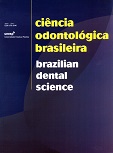Color unit differences (?E) of acrylic resins related to powder-to-liquid ratio, sample thickness and trade marks
DOI:
https://doi.org/10.14295/bds.2004.v7i2.483Abstract
The purpose of this study was to verify color differences (ΔE) of acrylic resins using specimens with 6, 4 and2mm of thickness. The acrylic resins tested were two medium pink - Clássico and Vipi - and three 66-shadematerials - Dencor (Clássico), Vipi-cor (Vipi) and Duralay (Reliance). By means of a spectrophotometer wereobtained the color parameters (L*, a*, b*). ΔE values were determined according to the following conditions: 1)+10, –10 and –20 powder/liquid ratios (in wt%) compared to the normal ratio recommended by the manufacturer;2) 4 and 2mm thicknesses compared to the 6mm control; 3) comparison between pink-colored resins andamong the three 66-colored resins. Results led us to conclude that under a clinical point of view, variations onthe powder/liquid ratio had little influence on color alteration when compared to the normal ratio, as the greatestvalue (ΔE=1.6) would not be noticeable by a large number of examiners. When compared to the 6mm control,it was demonstrated that specimens with 4mm of thickness did not show great color alteration (ΔE=1.7maximum), whereas the 2mm specimen suffered unsatisfactory alterations, which, depending on the materialand ratio, reached ΔE=8.4. Color similarity between pink-colored resins was good, but differences among 66-colored resin were unsatisfactory (up to ΔE=16.2).Downloads
Downloads
Published
How to Cite
Issue
Section
License
Brazilian Dental Science uses the Creative Commons (CC-BY 4.0) license, thus preserving the integrity of articles in an open access environment. The journal allows the author to retain publishing rights without restrictions.
=================




























